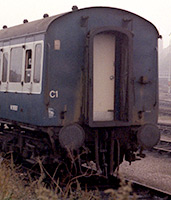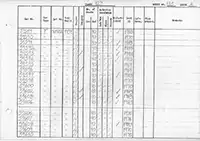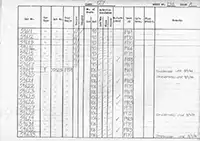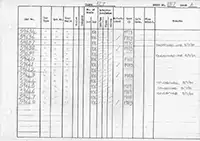Class 127 Derby 4-car DMUs
Description
Layout
When construction began around August 1958 the plans for the interior layout were as follows - the non-gangwayed high density sets were to have a capacity for 350 2nd class passengers in SR EMU style saloons and semi-compartments. The front saloon in each DMBS was to have 45 smoking seats with a swing door through to a 32 seat non-smoking section, beyond which was the guard and luggage area, although there was no through access. The TS had one large 52 seat smoking saloon, a 22 seat smoking saloon, a 12 seat "ladies only" compartment and a 22 seat non-smoking compartment. There was to be no through access between the compartments/saloons. The TS(L) had an 11 seat no-smoking compartment, a 29 seat smoking saloon, 2 toilets side by side, a 29 seat smoking saloon and a 21 seat non-smoking saloon. Doors on all bulkheads in this vehicle gave everybody in it access to the toilet.
By the time the sets were delivered a few alterations to these plans had taken place. In the TS there was no longer any separate ladies compartment, with the seating bay now linked to the non-smoking compartment forming a saloon of 32 seats, a loss of 2 seats for the vehicle. The DMBS no longer had the swing door between the two saloons, meaning an extra 2 seats in each car of this type. The number of seats in a set was now increased by 2 to 352. Interestingly, the door between the saloons in the DMBS was later added, reducing each DMBS to 76 seats, and a 4-car set to 348 seats.
Underframe
The underframe was of mild steel welded construction, 63ft 5in long over headstocks, and 46ft 6in between bogie centres. The solebars were a 7in x 3 1/2in channel section, and the main longitudinals were 10 3/4in deep welded angle and plate. The buffers, supplied by Garringtons Ltd, were the self contained type with rubber springs, supplied by George Spencer Moulton & Co Ltd, situated behind the underframe bolster. Rubber springs for the drawgear were supplied by the Clyde Rubber Works Co Ltd.
Bodyshell
The body and roof framing were of conventional BR design formed of 1/8 in thick steel of "top hat" section, with bodyside and roof panelling of 16 swg sheet steel. The cab roof domes were of moulded polyester glass laminate, incorporating four digit route indicators (the first DMUs to have them).
The floor consisted of 3/4 inch thick blockboard with 1/4 inch thick asbestos insulation sheet and a 16 swg light alloy panel on the underside. The interior of the bodyside, bodyends and roof space was filled with glass fibre for heat and sound insulation. Doors were from Lightalloys Ltd, and windows from Becket, Laycock & Watkinson Ltd.

In the image the vehicle is identified as a BSO (Brake Second Open) from a QUAD set, and was new on 6-10-59. Note the lining ended in a semi-circle rather than being squared off at the corners. Ian McDonald Collection.
Bogies/Brakes
The mild steel conventional design bogies had individual members partly fabricated and the main framing members rivited together. The centre castings and side friction castings were carried on resilient mountings and the bolsters had Armstrong hydraulic "Antisway" dampers to give some control of the swing-bolster movement. Timken taper-roller bearings were used throughout. The Gresham & Craven A.I.V. quick release system was used with engine driven Clayton Dewandre exhausters.
Electrics
The the 440ah 24v batteries were charged by engine driven generators on the power cars, and axle driven generators on the trailers. Generators were supplied by J Stone & Co (Deptford) Ltd. Inter-car connection was by 19-core PCP sheathed cables with 19 way plugs for which sockets were provided at the corner of each car.
AWS
When AWS was introduced a set featured in a British Pathe newsreel showing this new safety device.
Faults
The most serious problem between 1960 and 1966 was fires, mainly caused by defective exhausts, or cardan shafts breaking and puncturing fuel tanks. This resulted in the No. 2 engine exhaust pipe being re-routed, and the thickness of the cardan shaft wall increased. The fuel tank shapes were also redesigned, and the tank walls thickened. To aid evacuation, steps were added to the DMBS to help passengers climb down to the track safely, and an access door was formed in the wall dividing the two saloons.
The heavier Self Changing Gears Ltd. final drive had been used on other 238hp engined sets and showed promising results when used with mechanical transmission. However, when used with the torque converters on Class 127s they developed a number of weaknesses. These were mainly due to fractures of the striking fork, as happened on the lighter drives for 150hp engines, and failure of a lip of the parallel roller bearings which support and locate the secondary bevel gears. These bearings were strengthened and more positively located. The defects were normally detected during special depot examinations so few failures occurred due to this in service.
Blue Square Becomes Red Triangle
The sets were delivered with the Blue Square coupling code, which allowed them to couple to any other Blue Square sets (which the majority were). However, the driver had to alter his driving technique when a Class 127 was coupled to a set with mechanical transmission, and the Class 127s had speedometers segregated into four parts to help with this.
Power could not be applied until the final drives were engaged properly. Selecting any gear put the set into 'drive'. There was trouble if the driver had a mechanical set at the back and forgot to change gear - any speed was possible in gear - causing major problems for the gearbox in the mechanical set. Apparently there was a plate in front of the driver which could be lifted to reveal a reminder (something like "Gearbox Stock").
As the sets worked their services exclusively, coupling to other units was a rare occurrence. However, when some Class 112 Cravens sets (Rolls Royce engines and mechanical transmission) were transferred to the Moorgate line, this did occur. On the 27th June 1968 a Class 127 coupled to one of these Cravens was travelling at high speed near St Albans when a gearbox seized and caused a serious fire, and was attributed to improper driving. While most of the Cravens were withdrawn in the five months following the incident, the rest were restricted to Kentish Town - Barking services. In 1969 the 127s were rebranded the Red Triangle coupling code to prevent such an event happening again, though there were no technical modifications done to justify their own code. As they were still wired for Blue Square, they would have been in no way compatible with the West Riding Derby Lightweights had they still been in service, which had originally carried the Red Triangle code.
Gangways
Although the Class 127 sets were never fitted with gangways, soon after the trailers were sent to Tyseley they were given gangways to allow more flexibility in the type of service and area of operation that could be worked by the units, while providing better passenger comfort. The need for through gangways was necessary for the increasing number of 'Paytrain' services and as more use was made of DMUs for summer holiday and long distance relief passenger services.
The work was done at Carlisle Currock C&W repair shops, and involved cutting an aperture in the car ends following the removal of the interior and fascias and insulation material. New gangway hanger brackets were manufactured, and the gangway connectors and doors were taken from withdrawn Class 120 trailers. As they already had through access inside, no other interior work was required. The vehicle ends also required the run of the passenger communication cord and the water filler pipes to be repositioned.

TSL 59596 was the first Class 127 trailer to be tackled in November 1983. It was part of set TS 520, operating with power cars 53827 and 53880.
The gangways were the GWR 'suspended' style, as seen in the image of 59597 taken at Tyseley open day on 10/4/87 by Malcolm Clements.
Dimensions
| Length over headstocks | 63' 5" |
| Width over body panels | 9' 0" |
| Height - rail to top of roof | 12' 4 1/2" |
| Centre of bogies | 46' 6" |
| Bogie wheelbase | 8' 6" |
| Wheel diameter | 3' 0" |
For many years the Class carried tail lamps, even though they had marker lights built in. This was because union agreement over the use of the red bulbs in the marker lamps was not given until late 1982.
Asbestos
The vehicles were built without blue asbestos. The centre cars were included in a vehicle log kept by the RTC at Derby dated circa 1984 which included the asbestos status for each vehicle, the pages of which are included below.
In the asbestos columns the / meant they were not built with blue asbestos.
Summary
Background
Description
Power Train
Interiors
Works Photos
Diagrams & Design Codes
Driving Instructions
Numbering
Liveries
Operations
Accidents
Parcel Use
Images
Details about preserved Class 127s can be found here.
Also relavant is the article "Working the DMUs" by Cricklewood Driver Arno Brooks.





